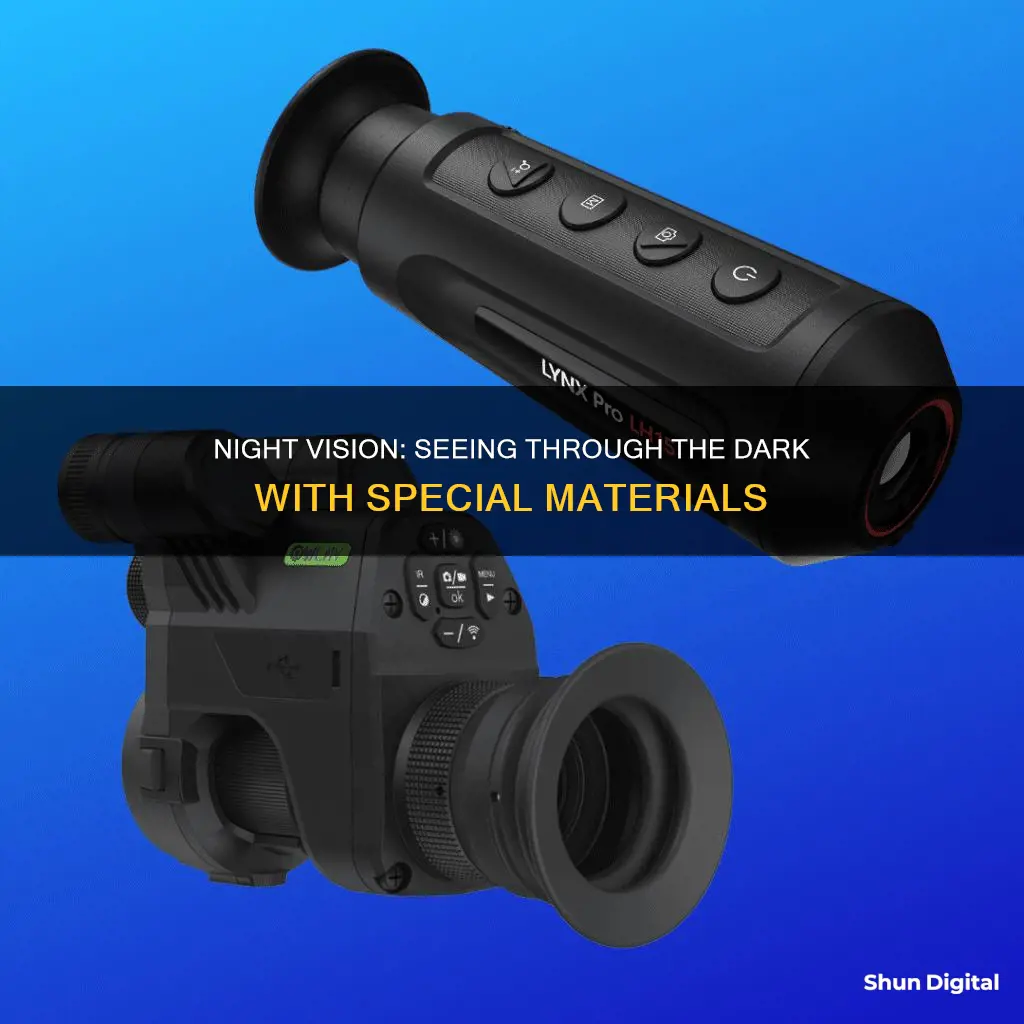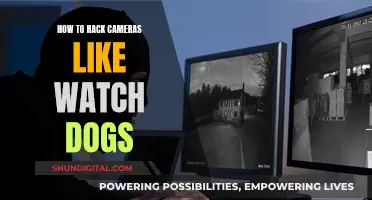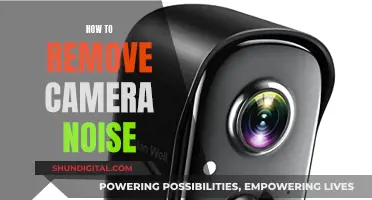
Night vision devices are used to see in the dark. They can be used to see people, animals, and objects up to 1,000 yards away on a dark night. There are two main types of night vision technology: image enhancement and thermal imaging. Image enhancement collects small amounts of light, including the lower portion of the infrared light spectrum, and amplifies it so that it can be observed by the human eye. Thermal imaging, on the other hand, captures the upper portion of the infrared light spectrum, which is emitted as heat by objects. Both technologies have their own advantages and are used in a variety of applications, from military operations to wildlife observation.
| Characteristics | Values |
|---|---|
| Technology | Night vision works in two ways: image enhancement and thermal imaging |
| Image enhancement | Collects tiny amounts of light, including the lower portion of the infrared light spectrum, and amplifies it |
| Thermal imaging | Captures the upper portion of the infrared light spectrum, emitted as heat by objects |
| Infrared light | Can be split into three categories: near-infrared, mid-infrared, and thermal-infrared |
| Near-infrared | Wavelengths range from 0.7 to 1.3 microns |
| Mid-infrared | Wavelengths range from 1.3 to 3 microns |
| Thermal-infrared | Occupies the largest part of the infrared spectrum, with wavelengths from 3 microns to over 30 microns |
| Thermal imaging use cases | Can be used to see if an area has been disturbed, e.g. ground dug up to bury something |
| Can show recent changes to areas such as walls, providing important clues in investigations | |
| Can be used by firefighters to see in smoke-filled buildings | |
| Can be used to monitor a building's unlit perimeter | |
| Can be used by helicopter pilots for a wide field of vision |
What You'll Learn

Night vision devices can see through infrared light
Night vision devices (NVDs) can be used to see in low-light conditions, enhancing the user's night vision. NVDs work by enhancing ambient visible light and converting near-infrared light into visible light that can be seen by humans. This process is known as image intensification (I2).
Infrared light is a type of radiation that is invisible to the human eye. It is located just outside the visible light spectrum and can be divided into three categories: near-infrared, mid-infrared, and thermal-infrared. Near-infrared has the shortest wavelengths, ranging from 0.7 to 1.3 microns, while mid-infrared wavelengths range from 1.3 to 3 microns. Thermal-infrared, on the other hand, has the longest wavelengths, ranging from 3 to over 30 microns.
NVDs work by collecting and amplifying the small amounts of light, including infrared light, that are present but may be imperceptible to the human eye. This light is then converted into an image that the user can see. The image created by NVDs is typically monochrome green, as green is considered the easiest colour for the human eye to see for prolonged periods in the dark.
There are two main types of night vision technologies: image enhancement and thermal imaging. Image enhancement collects and amplifies the available light, including infrared light, to create an image. On the other hand, thermal imaging captures the upper portion of the infrared light spectrum emitted as heat by objects. Warmer objects emit more of this light, allowing them to be detected by thermal imaging.
NVDs usually consist of an image intensifier tube, a protective housing, and an optional mounting system. Some NVDs also include a protective lens to prevent damage to the front lens. NVDs can be handheld or attached to helmets and firearms.
The development of NVDs has progressed through "generations", with each new generation bringing improvements in performance and reductions in price. The latest generation of NVDs offers enhanced resolution and sensitivity, providing clear and detailed images in low-light conditions.
Connecting a Camera to Your PC: A Step-by-Step Guide
You may want to see also

Night vision devices can see through thermal radiation
Night vision devices can be broadly classified into three types: image intensification, active illumination, and thermal imaging. While the first two technologies rely on the availability of natural or artificial light sources, thermal imaging devices can work in the absence of any light source.
Thermal imaging devices, also known as thermal imagers, detect heat or thermal energy (infrared) emitted by objects. They do not require any visible light to produce an image. The technology is based on detecting radiation, which increases with a rise in temperature. The thermal radiation is captured and displayed as a thermogram on a screen, with different colours representing varying temperatures. Objects with higher heat signatures are shown in bright yellow, orange, or red, while colder objects are depicted in darker colours.
Thermal imaging devices can detect minute temperature differences, with some advanced devices capable of sensing changes as small as 0.01°C. This allows users to see people or animals, who are typically warmer than their surroundings. However, cold-blooded animals like snakes and alligators are more challenging to detect as their body temperature adjusts to their environment.
Thermal imaging offers several advantages over other night vision technologies. It can see through dust, smoke, fog, and rain to some extent, conditions that impair the performance of image intensification night vision devices. Thermal imaging can also see through thin materials and foliage, making it valuable for surveillance and hunting. Additionally, thermal imaging does not require any light to function, making it effective in complete darkness.
While thermal imaging provides excellent detection capabilities, it may not be ideal for recognition or identification. Objects or individuals wearing camouflage or standing still at a distance can be challenging to identify. In such cases, combining thermal imaging with night vision rifle scopes can be a solution.
Golf Ball Tracking: TV Cameras' Secrets Revealed
You may want to see also

Night vision devices can see through low-light conditions
Night vision devices are designed to enhance visibility in low-light conditions, and they achieve this through advanced technological features. These devices can be categorised into three main types: image intensification, active illumination, and thermal imaging. Each type of technology offers unique advantages and applications.
Image intensification is a widely recognised night vision technology. It involves magnifying the amount of received photons from natural sources such as starlight or moonlight. Devices like night glasses and low-light cameras fall under this category. Image intensifiers, often called "Low Light TV" in military contexts, can generate images from a minimal number of photons, allowing users to observe dimly lit scenes in real time. The image intensifier tube, a critical component in these devices, collects and amplifies infrared and visible light.
Active illumination combines imaging intensification with an active source of illumination in the near-infrared (NIR) or shortwave infrared (SWIR) band. This technology is commonly employed in low-light cameras, enhancing night-time imaging capabilities. Active infrared night-vision systems use infrared illumination, which is invisible to the human eye, along with CCD cameras sensitive to this light. As a result, a scene that appears dark to a human observer is transformed into a clear monochrome image on a display device.
Thermal imaging is another powerful night vision technology that detects the temperature differences between objects. It captures the upper portion of the infrared light spectrum, which is emitted as heat by objects. This technology is particularly useful for detecting warm bodies or distinguishing disturbed areas, such as dug-up ground. Thermal imaging cameras do not rely on a source of illumination and can even see through light fog, rain, and smoke to a certain extent. They are widely used in security applications and aircraft systems, where they are known as "FLIR" (Forward-Looking Infrared).
Night vision devices have become increasingly accessible to civilians, enhancing safety in various sectors. They are now integrated into aircraft systems to improve pilot situational awareness and prevent accidents. Additionally, automotive night vision systems are available as optional equipment in certain premium vehicles, aiding drivers in poor lighting or weather conditions.
Rendering Camera View in Blender: A Guide to Camera Viewport Rendering
You may want to see also

Night vision devices can see through fog, rain, and smoke
Night vision devices can be incredibly useful in low-visibility conditions, such as fog, rain, and smoke. While they cannot see through solid objects, glass, or acrylic, they can help users navigate through these challenging conditions by detecting objects that would otherwise be invisible to the naked eye.
Night vision devices work through image enhancement or thermal imaging. Image enhancement collects the tiny amounts of light, including the lower portion of the infrared light spectrum, and amplifies it so that we can observe the image. Thermal imaging, on the other hand, captures the upper portion of the infrared light spectrum, which is emitted as heat by objects. Warmer objects emit more of this light than cooler objects.
In the case of fog, rain, and smoke, thermal imaging cameras are particularly effective. They can detect the heat signatures of objects beyond these obstructions. For example, in a smoke-filled room, a thermal imaging camera can detect the heat signature of a human body, allowing firefighters to locate individuals who may be trapped. Similarly, in foggy conditions, a thermal camera can detect objects beyond the fog layer, improving visibility for drivers or aircraft pilots.
However, it is important to note that the effectiveness of thermal imaging cameras in these situations depends on various factors. These include the thickness of the fog, rain, or smoke; the temperature of objects behind these obstructions; and the sensitivity of the camera. For instance, in dense smoke-filled environments, the camera's effectiveness may be reduced as the smoke absorbs and scatters the infrared radiation emitted by objects. Additionally, cooler objects may be harder to detect as they emit less infrared radiation.
Despite these limitations, thermal imaging cameras can still provide valuable assistance in low-visibility conditions caused by fog, rain, or smoke. They are widely used in firefighting, search and rescue operations, surveillance, and navigation.
The Red H Logo and Q-See Camera Mystery Explained
You may want to see also

Night vision devices can see through darkness
Night vision devices work in two main ways: image enhancement and thermal imaging. Image enhancement collects the tiny amounts of light, including the lower portion of the infrared light spectrum, and amplifies it so that we can observe the image. This process involves the use of an image intensifier tube, which captures and amplifies visible and infrared light reflected off objects. The tube contains a photocathode, which converts photons to electrons, and a microchannel plate, which multiplies the number of electrons to amplify the signal. The electrons then hit a phosphor-coated screen, creating a bright green image.
On the other hand, thermal imaging captures the upper portion of the infrared light spectrum, which is emitted as heat by objects. Objects with higher temperatures, such as warm bodies, emit more of this light than cooler objects like trees or buildings. Thermal imaging cameras detect these temperature differences and produce an image, which can be useful for detecting hidden objects or areas that have been disturbed.
While night vision devices are incredibly useful for seeing in the dark, they do have some limitations. For example, traditional night vision devices require at least some ambient light to function, and they may not work well on cloudy or moonless nights. Additionally, night vision devices typically have a limited field of view, requiring users to turn their heads frequently.
Philips 55PFL5601 F7: Is There a Camera Feature?
You may want to see also
Frequently asked questions
Night vision cameras use either image enhancement or thermal imaging technology. Image enhancement collects tiny amounts of light, including the lower portion of the infrared light spectrum, and amplifies it. Thermal imaging, on the other hand, captures the upper portion of the infrared light spectrum, which is emitted as heat by objects.
Night vision cameras can see through materials that allow some form of light or heat to pass through. This includes thin fabrics, glass, plastics, and other materials that are not completely opaque. However, thicker or more reflective materials may obstruct the view of a night vision camera.
No, night vision cameras cannot see through solid objects like walls. They rely on detecting and amplifying light or heat, which cannot penetrate solid objects.
No, night vision cameras require at least some form of light to function. In very low light conditions, night vision devices may struggle to produce clear images.
In addition to solid objects, night vision cameras are limited by distance, field of view, and the intensity of light or heat available. They also have limited ability to reproduce colours accurately and may produce monochrome or green-tinted images.







